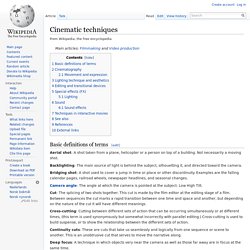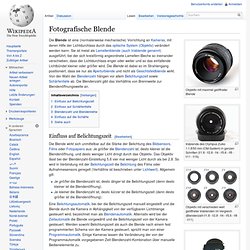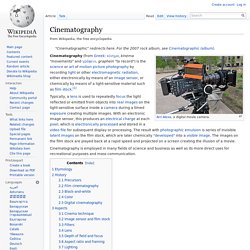

Cinematic techniques. Basic definitions of terms[edit] Aerial shot: A shot taken from a plane, helicopter or a person on top of a building.

Not necessarily a moving shot. Backlighting: The main source of light is behind the subject, silhouetting it, and directed toward the camera. Bridging shot: A shot used to cover a jump in time or place or other discontinuity. Examples are the falling calendar pages, railroad wheels, newspaper headlines, and seasonal changes. Camera angle: The angle at which the camera is pointed at the subject: Low High Tilt. Cut: The splicing of two shots together. Cross-cutting: Cutting between different sets of action that can be occurring simultaneously or at different times, (this term is used synonymously but somewhat incorrectly with parallel editing.)
Continuity cuts: These are cuts that take us seamlessly and logically from one sequence or scene to another. Deep focus: A technique in which objects very near the camera as well as those far away are in focus at the same time. Fotografische Blende. Objektiv mit maximal geöffneter Blende Irisblende des Olympus Zuiko 1:1,8/50 mm (OM-System) in ganzen Schritten (f/1.8 - f/2.8 - f/4 - f/5.6 - f/8 - f/11 - f/16) Objektiv mit verschieden weit geöffneter Irisblenden im Vergleich (Blendenzahl f/1.8 - f/2.8 - f/4 - f/5.6 - f/8 - f/11) Einfluss auf Belichtungszeit[Bearbeiten] Je größer die Blendenzahl ist, desto länger ist die Belichtungszeit (denn desto kleiner ist die Blendenöffnung).Je kleiner die Blendenzahl ist, desto kürzer ist die Belichtungszeit (denn desto größer ist die Blendenöffnung).

Eine Belichtungsautomatik, bei der die Belichtungszeit manuell eingestellt und die Blende durch die Kamera in Abhängigkeit von der verfügbaren Lichtmenge gesteuert wird, bezeichnet man als Blendenautomatik. Einfluss auf Schärfentiefe[Bearbeiten] Im Sprachgebrauch der Fotografie wird der Begriff Blende oft auch als Kurzform für Blendenöffnung benutzt, und beispielsweise anstatt von großer Blendenöffnung von großer Blende gesprochen. Angle of view. A camera's angle of view can be measured horizontally, vertically, or diagonally.

In photography, angle of view describes the angular extent of a given scene that is imaged by a camera. It is used interchangeably with the more general term field of view. It is important to distinguish the angle of view from the angle of coverage, which describes the angle range that a lens can image. Typically the image circle produced by a lens is large enough to cover the film or sensor completely, possibly including some vignetting toward the edge. If the angle of coverage of the lens does not fill the sensor, the image circle will be visible, typically with strong vignetting toward the edge, and the effective angle of view will be limited to the angle of coverage. Calculating a camera's angle of view[edit] For lenses projecting rectilinear (non-spatially-distorted) images of distant objects, the effective focal length and the image format dimensions completely define the angle of view.
Radians or Now and. Cinematography. Cinematography (from Greek: κίνημα, kinema "movements" and γράφειν, graphein "to record") is the science or art of motion picture photography by recording light or other electromagnetic radiation, either electronically by means of an image sensor, or chemically by means of a light-sensitive material such as film stock.[1] Cinematography is employed in many fields of science and business as well as its more direct uses for recreational purposes and mass communication.

§Etymology[edit] The word "cinematography" was created from the Greek roots κίνημα (kinema) i.e "motion" and γραφή (graphé) "representation by means of lines" or "drawing", together meaning drawing motion. §History[edit] §Precursors[edit] Muybridge sequence of a horse galloping In the 1830s, moving images were produced on revolving drums and disks, with independent invention by Simon von Stampfer (Stroboscope) in Austria, Joseph Plateau (Phenakistoscope) in Belgium and William Horner (zoetrope) in Britain. §Black-and-white[edit]